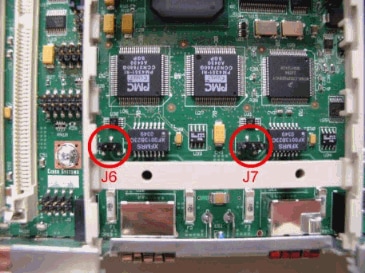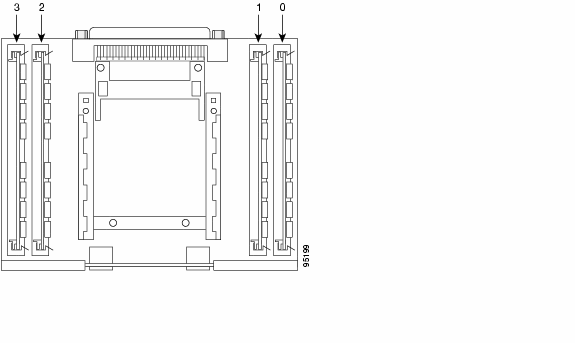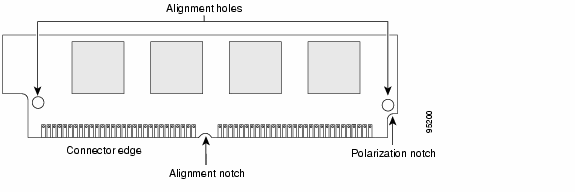Understand the NM-HDV2 IP Communications High-Density Digital Voice or Fax Network Module
Available Languages
Contents
Introduction
The NM-HDV2 IP Communications High-Density Digital Voice or Fax Network Modules combines WAN Interface Card (WIC) and Voice Interface Card (VIC) functionality to provide unparalleled flexibility and power. The NM-HDV2 is able to support up to an optimal maximum of 256 voice channels. The actual ceiling on voice and fax capability set by the combination of physical digital and physical analog Telephony interfaces, codec complexity operation desired, and transcoding or conferencing requirements.

Prerequisites
Requirements
There are no specific requirements for this document.
Components Used
This document is not restricted to specific software and hardware versions.
Conventions
Refer to the Cisco Technical Tips Conventions for more information on document conventions.
Product Numbers
This table lists the NM-HDV2 IP Communications High-Density Digital Voice or Fax Network Module variants, and the product numbers to which they correspond.
Table 1
| NM-HDV2 Products | Description |
|---|---|
| NM-HDV2 | IP Communications High-Density Digital Voice or Fax Network Module, with no onboard T1/E1 controllers and one VIC/VWIC slot |
| NM-HDV2-1T1/E1 | One-port T1/E1 IP Communications High-Density Digital Voice or Fax Network Module, with one onboard T1/E1 controller and one VIC/VWIC slot |
| NM-HDV2-2T1/E1 | Two-port T1/E1 IP Communications High-Density Digital Voice or Fax Network Module, with two onboard T1/E1 controllers and one VIC/VWIC slot |
This table lists the digital signal processor (DSP) module variants that are used in the NM-HDV2 IP Communications High-Density Digital Voice or Fax Network Modules, and the product numbers to which they correspond.
Table 2
| PVDM2 Products | Description | Maximum Number of Voice/FAX Channels per Codec Complexity | |||
|---|---|---|---|---|---|
| Flexi Complexity (FC) (Default Setting) G.711 (Optimal Use) | Flexi Complexity (Default Setting) All Medium Complexity (MC) and High Complexity (HC) Codecs | Medium Complexity G.729A, G.729AB, G.726, G.711, Clear-Channel, GSMFR, Fax Relay/PassThrough, Modem PassThrough | High Complexity All MC Codecs and also G.723, G.728, G.729, G.729B, GSMEFR | ||
| PVDM2-8 | 8-channel packet fax/voice DSP module, contains one Texas Instruments (TI) C5510 DSP | 8 | 4-8 | 4 | 4 |
| PVDM2-16 | 16-channel packet fax/voice DSP module, contains one TI C5510 DSP | 16 | 6-16 | 8 | 6 |
| PVDM2-32 | 32-channel packet fax/voice DSP module, contains two TI C5510 DSPs | 32 | 12-32 | 16 | 12 |
| PVDM2-48 | 48-channel packet fax/voice DSP module, contains three TI C5510 DSPs | 48 | 18-48 | 24 | 18 |
| PVDM2-64 | 64-channel packet fax/voice DSP module, contains four TI C5510 DSPs | 64 | 24-64 | 32 | 24 |
Features of the NM-HDV2
Some of the features of the NM-HDV2 IP Communications High-Density Digital Voice or Fax Network Module are described in this section.
Telephony Interfaces
-
Up to two onboard T1/E1 controllers on the base NM-HDV2 module, with software-selectable T1 or E1 personality through the Cisco IOS® Software CLI. Both onboard controllers must be T1 or both must be E1.
Note: When the onboard controllers are configured for E1 mode, it is possible that the E1 controllers may not come up properly even when connected to known good E1 Telco lines. The output of the show controllers E1 command can indicate large accumulations of Line Code Violations (LCVs) and Path Code Violations (PCVs). The problem can be the result of how the E1 line has been provisioned by the Telco; specifically whether Wet Current is provided or not. On the NM-HDV2 product there are two jumper blocks which control whether the onboard T1/E1 controllers support Wet Current or not. These jumpers are identified on the Printed Circuit Board (PCB) of the Network Module as J6 and J7 (see photograph). J6 is the jumper block for onboard controller 1 while J7 is the jumper block for onboard controller 0. The pin count for each jumper block is from 1 to 3. Pin 1 is the rightmost pin and Pin 3 is the leftmost pin. When Pins 1 and 2 are short-circuited (Right Jumper Setting) the onboard controller is set for "Wet Current Mode", and when Pins 2 and 3 are short-circuited (Left Jumper Setting) the onboard controller is set for "Normal Mode". Early production NM-HDV2s shipped with the jumper blocks set to expect Wet Current to be supplied by the Telco, and this causes problems for some E1 users. When you move the setting to Normal Mode, it typically clears up the problem. Current production NM-HDV2s now ship with the jumper blocks set for Normal Mode.

-
Accepts any of the VWIC-1MFT-T1, VWIC-2MFT-T1, VWIC-2MFT-T1-DI, VWIC-1MFT-E1, VWIC-2MFT-E1, VWIC-2MFT-E1-DI, VWIC-1MFT-G703, and VWIC-2MFT-G703 products in the VIC/VWIC slot to permit up to a total of four simultaneous T1/E1 voice controllers. For more information with regard to VWICs, refer to Understanding 1-Port and 2-Port E1 Multiflex Trunk Voice/WAN Interface Cards (VWICs).
-
Accepts any of the VIC2-2FXS, VIC2-2FXO, VIC2-4FXO, VIC2-2E/M, VIC2-2BRI-NT/TE, VIC-2DID, VIC-4FXS/DID, and VIC-1J1 voice cards in the VIC/VWIC slot to permit analog, BRI, and J1 voice connectivity.
Note: On the NM-HDV2, NM-HD-1V, NM-HD-2V, and NM-HD-2VE Network Modules, the VIC-2DID only operates in Direct-Inward-Dial (DID) mode (not Foreign Exchange Station [FXS] mode), until Cisco IOS Software Release IOS 12.4(3) and later. The VIC-4FXS/DID only operates in FXS mode (not DID mode) until Cisco IOS Software Release IOS 12.3(14)T and later. Software selectable DID or FXS mode is supported on both VICs in Cisco IOS Software Release 12.4(3) and later.
DSP Resources
-
Uses the Packet Voice DSP Module, Generation 2 (PVDM2) series of DSP cards.
-
Each PVDM2 DSP card contains from one to four TI C5510 DSPs, dependant upon the particular product.
-
Each TI C5510 DSP can be configured to operate in one of three codec complexity settings:
-
Flexi Complexity (FC)
-
Medium Complexity (MC)
-
High Complexity (HC)
For more information with regards to the concept of codec complexity, refer to Understanding Codecs: Complexity, Hardware Support, MOS, and Negotiation. The default codec complexity setting is to use FC mode.
-
-
Each TI C5510 DSP can optimally support 16 G.711 voice channels in FC mode. For other codecs in FC mode, or if the DSPs are configured for MC or HC mode, the number of simultaneous voice channels that can be supported is shown in Table 2.
-
PVDM2 DSP cards fit into single inline memory module (SIMM) sockets on the NM-HDV2 network modules.
-
Four PVDM2 SIMM sockets are available on the NM-HDV2 network modules, which allows for a maximum of 16 onboard C5510 DSPs (four PVDM2-64 cards installed).
-
DSP resources may be oversubscribed, which means that digital voice interfaces may be configured to support up to as many voice channels as the DSPs can optimally support. Actual limits on how many simultaneous voice calls can be supported depends on the mixture of codecs requested of the DSPs.
-
DSP resources may be reserved for analog and BRI voice ports to ensure that there are DSP channels dedicated to these ports during DSP oversubscription scenarios.
Signal and General Voice Features
-
T1/E1 Channel Associated Signaling (CAS) (which includes E1 R2), ISDN PRI Q.931, and Q.SIG signaling.
-
VIC2-2FXO and VIC2-4FXO can be configured for Enhanced 911 Centralized Automatic Message Accounting (CAMA) operation.
-
Analog-to-digital channel bank operation within the NM-HDV2.
-
DSP sharing between multiple NM-HDV2 modules on the same voice router.
-
Use of DSPs as a transcoding or conferencing resource. This feature requires Cisco IOS Software Release 12.3(8)T or later. For more information, refer to Configuring Enhanced Conferencing and Transcoding for Voice Gateway Routers.
-
Drop-and-Insert (D&I) of timeslots from one T1/E1 voice interface to another.
-
Supported with H.323, Media Gateway Control Protocol (MGCP), and Session Initiation Protocol (SIP).
-
VoIP, VoFR, and VoATM (AAL2 and AAL5) support.
-
Cisco CallManager support in release 3.3(4) or later, or 4.0(1)SR1 or later.
-
Connection Trunk and Transparent Common Channel Signaling (T-CCS) (frame-forwarding and clear-channel).
-
Hoot & Holler multicast voice traffic.
-
Fax and Modem PassThrough, Fax Relay. At this time Modem Relay is not supported.
-
G.168-compliant Echo Cancellation.
-
DSP-less (hairpin) POTS-to-POTS calls within the same NM-HDV2. This can enable BRI-to-PRI video Time Division Multiplexing (TDM) switching.
Data and Miscellaneous Features
-
Channel-groups can be defined on any T1/E1 controller to generate serial interfaces for HDLC, Frame-Relay, and PPP connectivity.
-
Thirty-two High-Level Data Link Control (HDLC) controllers available to support data connectivity through channel-group configuration (a PRI group also counts as one data connection).
-
Maximum aggregate throughput of all channel-groups defined on the NM is 2 Mbps.
-
Ability to participate in chassis Time Division Multiplexing (TDM) backplane clocking, if applicable.
-
Dual independent clock domains for onboard T1/E1 controllers, provided at least one controller is used only for data connectivity.
-
Online Insertion and Removal (OIR) is supported, but only on the Cisco 3745 and 3845 platforms.
Software Requirements for Selected Features
This table outlines specific software requirements for features not supported in the first Cisco IOS Software release for the NM-HDV2 product.
Table 3
| Feature | Software Requirement |
|---|---|
| Transcoding and Conferencing | Cisco IOS Software Release12.3(8)T and later |
| DID Support on the VIC-4FXS/DID Card | Cisco IOS Software Release 12.3(14)T and later |
| FXS Support on the VIC-2DID Card | Cisco IOS Software Release 12.4(3) and later |
| Cisco Call Manager MGCP Support | Cisco CallManager Release 3.3(4)0 or later, or 4.0(1)SR1 or later |
For more information about the features of the NM-HDV2, refer to these documents:
NM-HDV2 Top View of PVDM2 Slot Locations 
DSP IDs on the NM-HDV2 PVDM2 Packet Voice DSP Modules
When you configure a DS0 group or a PRI group, the timeslots are assigned DSP channels dynamically each time a new voice call is placed. These are the IDs of the DSPs:
-
The DSPs on the PVDM2 in SIMM socket 0 have IDs 1, 2, 3, 4
-
The DSPs on the PVDM2 in SIMM socket 1 have IDs 5, 6, 7, 8
-
The DSPs on the PVDM2 in SIMM socket 2 have IDs 9, 10, 11, 12
-
The DSPs on the PVDM2 in SIMM socket 3 have IDs 13, 14, 15, 16
Issue the show voice dsp command to view DSP ID information.
PVDM2 (Packet Voice DSP Module, Generation 2) 
Platform Support
This table outlines the platform support for the NM-HDV2 IP Communications High-Density Digital Voice or Fax Network Modules.
Table 4
| Cisco IOS Software Support1 | 2600XM, 2691, 3725, 3745 | 2811, 2821, 2851 | 3825, 3845 |
|---|---|---|---|
| NM-HDV2, NM-HDV2-1T1/E1, NM-HDV2-2T1/E1 | 12.3(7)T | 12.3(8)T4 | 12.3(11)T |
| PVDM2-8, PVDM2-16, PVDM2-32, PVDM2-48, PVDM2-64 | 12.3(7)T | 12.3(8)T4 | 12.3(11)T |
1 Voice features require a "PLUS" image in Cisco IOS Software classic feature sets, or an appropriate selection from the list of Cisco IOS Software cross-platform feature sets. For more information, refer to Product Bulletin No. 2089: Cisco IOS 12.3 Mainline and 12.3T Feature Sets for Cisco 2691.
Note: The Cisco IOS Software versions provided are typically the minimum version required to support the platform, module, or feature in question. To find a complete list of Cisco IOS Software versions a feature, module, interface card, or chassis is supported in, use the Software Advisor (registered customers only) tool.
Related Information
Revision History
| Revision | Publish Date | Comments |
|---|---|---|
1.0 |
09-Dec-2004 |
Initial Release |
Contact Cisco
- Open a Support Case

- (Requires a Cisco Service Contract)

 Feedback
Feedback